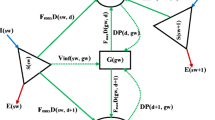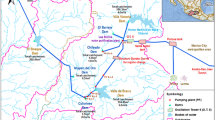Abstract
Produced water constitutes a large amount of waste fluids during the production operation of an oil field. Underground injection for disposing the wastewater from hydrocarbon production is an engineering problem due to the possibility of leakage of injected pollutant material from receiving medium to a drinking water source. This paper describes a method for optimization of polluted aquifer remediation design using one of the artificial intelligence optimization methods, namely Genetic Algorithms (GAs). As a case study, the contaminated area was created by using a groundwater transport simulator, which is based on Method of Characteristics (MOC). Then, the developed computer program was run to find the optimum solution for remediation, and the solution yielded from the program was verified by using a groundwater simulator. The plume was captured and the concentration level of chloride ion within the aquifer was diminished by using extraction wells. The analytical model approach provided different alternatives for appropriate isolation of plume. GAs were used as an optimization technique for making a decision among the alternatives, by considering operation time, number of wells, pumping rate and drawdown as decision variables and constraints.
Similar content being viewed by others
References
Aral, M.M. and Guan, J.: 1996, Genetic algorithms in search of groundwater pollution sources, Proc. Advances in Groundwater Pollution Control and Remediation, NATO ASI Series 2/9, Antalya, Turkey.
Chambers, L.: 1995, Practical Handbook of Genetic Algorithms, Applications, 1, Boca Raton, CRC Press.
Cieniawski, S. E., Eheart, J. W. and Ranjithan, S.: 1995, Using genetic algorithms to solve multiobjective groundwater monitoring problem, Water Resour. Res. 31(2), 399–409.
Fetter, C. W.: 1993, Contaminant Hydrogeology, Prentice Hall, pp. 392–415.
Glover, E. W.: 1982, Containment of contaminated groundwater–an overview, Proc. Second National Symposium on Aquifer Restoration and Groundwater Monitoring, National Water Well Association, Worthington, OH, pp. 17–22.
Goldberg, D. E.: 1989, Genetic Algorithms in Search, Optimization and Machine Learning, pp. 60–77, pp. 327–349.
Gorelick, S. M. and Wagner, B. J.: 1986, Evaluating strategies for groundwater contaminant plume stabilization and removal, Selected Papers in the Hydrologic Sciences, U.S., Geological Survey Water-Supply Series 2290, pp. 81–89.
Hadj-Alouane, B. A. and Bean, J. C.: 1997, A genetic algorithm for the multiple-choice integer program, Operations Res. 1(45), 92–101.
Javandel, I. and Tsang, C. F.: 1986, Capture-zone type curves: A tool for aquifer cleanup, Ground Water 5(24), 616–625.
Jefferys, E. R.: 1993, Design Applications of Genetic Algorithms, SPE 26367, presented at the 68th Annual Technical Conference and Exhibition of the Society of Petroleum Engineers, Houston, Texas, October 3–6.
Konikow, L. F. and Bredehoeft, J. D.: 1978, Computer Model of Two-Dimensional Solute Transport and Dispersion in Groundwater, MOC, in Technologies of Water-Resources Investigations of the United States Geological Survey, U.S. Government Printing Office, Washington, DC, Book 7, Chap. 2.
Kuru, E. and Gümrah, F.: 1992, An overview of environmental problems originating from oil-field operations and their solutions, Proc. 9th Petroleum Congress of Turkey, February 17–21, Ankara, 276–294.
McCormack, M. D. and Day R.: 1993, How artificial intelligence impacts E&P productivity, World Oil, pp. 81–87.
McKinney, D. C. and Lin, M. D.: 1994, Genetic algorithm solution of groundwater management models, J. Water Resour. Res. 30(6), 1897–1906.
Michalewicz, Z.: 1992, Genetic Algorithms Data Structures Evolution Programs, New York, pp. 31–42.
Press, W. H., Flannery, B. P., Teukolsky, S. A. and Vetterling, W. T.: 1993, Numerical Recipes in C: The Art of Scientific Computing, 2nd edn, Cambridge University Press, New York.
Prickett, T. A., Naymik T. G. and Lonnquist C. G.: 1981, A random walk solute transport model for selected groundwater quality evaluations, State Water Surv. Bull. Ill, pp. 65–104.
Ranjithan, S. J., Eheart, W. and Liebman, J.: 1992, Incorporating fixed-cost component of pumping into stochastic groundwater management, A genetic algorithm based optimisation approach, EOS Trans., AGU, 74(14), Spring Meeting Suppl., pp. 125–133.
Reis, L. F. R., Porto R. M. and Chaudhry, F. H.: 1997, Optimal location of control valves in pipe networks by genetic algorithms, J. Water Resour. Planning and Management (Nov.–Dec.) 317–326.
Ritzel, B. J. and Eheart, W.: 1994, Using genetic algorithms to solve a multiple objective groundwater pollution containment problem, J. Water Resour. Res. 30(5), 1589–1603.
Rizzo, D. M and Dougherty, D. E.: 1996, Design optimization for multiple management period groundwater remediation, J. Water Resour. Res. 32(8), 2549–2561.
Satkin, R. L. and Bedient, P. B.: 1988, Effectiveness of various aquifer restoration schemes under variable hydrogeologic conditions, Ground Water 26(4), 488–498.
Schuette, J. F. and Pevear, D. R.: 1995, Matchmod: A genetic algorithm to interpret X-ray diffraction patterns, In: B. Braunschweig and R. Day (eds), Artificial Intelligence in the Petroleum Industry, Symbolic and Computational Applications, Editions Technip, Paris, 1995, Chap. 14, pp. 397–415.
Sen, M. K., Akhil D. G., Stoffa, P. L., Lake, L. W. and Pope, G. A.: 1992, Stochastic reservoir modeling using simulated annealing and genetic algorithm, SPE 24754, Presented at the 67th Annual Technical Conference and Exhibition of the Society of Petroleum Engineers, Washington, DC, October 4–7.
Shafer, J. M.: 1984, Determining optimum pumping rates for creation of hydraulic barrier to groundwater pollutant migration, Proc. 4th National Symposium on Aquifer Restoration and Ground Water Monitoring, National Water Well Association, Washington, OH, pp. 50–60.
Simpson, A. R., Dandy, G. C. and Murphy, L. J.: 1994, Genetic algorithms compared to other techniques for pipe optimization, J. Water Resour. Planning and Management ASCE 120(4), 423–443.
Stoffa, P. L. and Sen, M. K.: 1991, Nonlinear multiparameter optimisation using genetic algorithms: inversion of plane-wave seismograms, Geophysics 56, 1794–1810.
Wagner, B. J.: 1995, Recent advances in simulation-optimization groundwater management modeling, Natl. Rep. Int., Union Geod. Geo-Phys., 1991–1994, Rev. Geophys. 33, 1021–1028.
Author information
Authors and Affiliations
Rights and permissions
About this article
Cite this article
Gümrah, F., Erbas, D., Öz, B. et al. Genetic Algorithms for Optimizing the Remediation of Contaminated Aquifer. Transport in Porous Media 41, 149–171 (2000). https://doi.org/10.1023/A:1006774101991
Issue Date:
DOI: https://doi.org/10.1023/A:1006774101991




